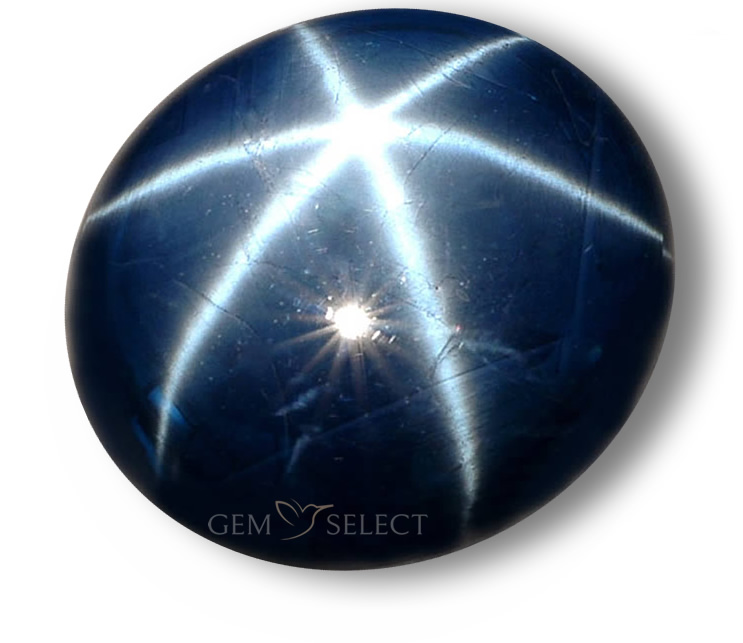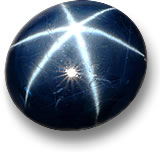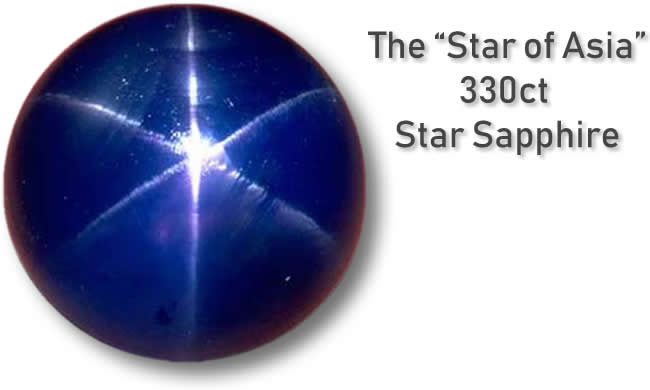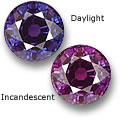Star Sapphire Gemstone Information

About Star Sapphire - History and Introduction
Star sapphire is a rare variety of sapphire that exhibits a unique asterism under specific lighting conditions. When viewing star sapphire, a six-rayed star appears to float across the surface of the stone. This effect is best observed under a direct light source while tilting and rotating the stone from different angles. The phenomenon stems from tiny needle-like inclusions of rutile within the gem.
Play HD Video Demonstrating Star Sapphire Asterism
These aligned needles intersect at varying angles, creating the star pattern through light reflection off the rutile inclusions, which are mainly titanium dioxide and appear white. Star sapphires come in colors ranging from various blues to Pink Sapphire, Orange Sapphire, Yellow Sapphire, Green Sapphire, Teal Sapphire, lavender, gray, or black. The most sought-after is a vivid, intense blue. If you're curious about variations, Thai star sapphires are known for their golden asterism.
Sapphire Gemstone Information: Sapphire belongs to the corundum family, closely related to ruby, which is the red to pink-red variety of corundum. All corundum rates 9 on the hardness scale, making it the second hardest material after diamond. The name 'corundum' derives from the Sanskrit 'kuruvindam,' meaning 'ruby sapphire,' and 'sapphire' comes from the Persian 'safir,' rooted in the Greek word for 'blue.'

Identifying Star Sapphire
Star sapphire stands out from other sapphires due to its distinctive asterism. The six-rayed star shows most clearly under natural light or a strong direct source like a penlight or halogen bulb. It has no cleavage planes and boasts a hardness of 9 on the Mohs scale. Chemically, it's aluminum oxide forming trigonal crystals. Thanks to its exceptional hardness and durability, star sapphire is hard to mistake, though it might be confused with gems like star garnet or star diopside that share similar colors and luster.
Star Sapphire Origin and Sources
Key deposits of fine star sapphire are located in Australia, Myanmar (Burma), Sri Lanka, and Thailand. Other notable sources include Brazil, Cambodia, China, Kenya, Madagascar, Malawi, Nigeria, Pakistan, Rwanda, Tanzania, the United States (Montana), Vietnam, and Zimbabwe.
Buying Star Sapphire and Determining Value
Star Sapphire Color
Star sapphires vary in hue from different blues to Pink Sapphire, Orange Sapphire, Yellow Sapphire, Green Sapphire, Teal Sapphire, lavender, gray, and black. Blue tones result from iron and titanium, violet from vanadium. A small amount of iron results in more yellow (including Pukhraj Yellow Sapphire) or green shades, while chromium produces fine pink to red tones. Iron and vanadium result in golden to orange tones. The most desirable color is a vivid, intense blue. Thai star sapphire is famed for its golden rayed star.
Explore Different Colors of Sapphires for a comprehensive overview.
Star Sapphire Clarity and Luster
Typically opaque, finer star sapphires may show slight translucency. The asterism comes from aligned rutile needles, leading to a vitreous or silky luster when polished.
Star Sapphire Cut and Shape
These gems are cabochon-cut with high domes to highlight the star effect. Ideal cabochons are somewhat translucent with smooth, symmetrical domes. Look for even roundness, though some unevenness may be needed to center the asterism properly.
Star Sapphire Treatment
Heat treatment is common, heating stones to 1700-1800°C (3100-3300°F) for hours to enhance color and clarity. Reputable dealers disclose this. Diffusion with titanium can sharpen the star effect.
Star Sapphire Gemological Properties
| Chemical Formula: | Al2O3 Aluminum oxide |
| Crystal Structure: | (Trigonal) doubly pointy, barrel-shaped, hexagonal pyramids, tabloid-shaped |
| Color: | Blue in various tones, pink, yellow, green, lavender, gray, black |
| Hardness: | 9 on the Mohs scale |
| Refractive Index: | 1.762 to 1.778 |
| Density: | 3.95 to 4.03 |
| Cleavage: | None |
| Transparency: | Transparent, translucent, opaque |
| Double Refraction or Birefringence: | -0.008 |
| Luster: | Vitreous, silky |
| Fluorescence: | Blue: none; colorless: orange-yellow, violet |
Please refer to a gemstone glossary for details on gemology-related terms.
Star Sapphire Mythology, Metaphysical and Crystal Healing
Sapphire is the birthstone for September and linked to Taurus in the zodiac.
In ancient times, star sapphires were seen as potent talismans for travelers and seekers, so powerful they protected even after being passed on.
Abbess Hildegard von Bingen (1098-1179) wrote in 'Physica' about gemstones' healing powers from water and fire, each with divine blessings. On sapphire: "Who is dull and would like to be clever, should, in a sober state, frequently lick with the tongue on a sapphire, because the gemstone's warmth and power, combined with the saliva's moisture, will expel the harmful juices that affect the intellect. Thus, the man will attain a good intellect."

Disclaimer: Metaphysical and Alternative Crystal Healing Powers and Properties are not to be taken as confirmed advice. Traditional, Ceremonial and Mythological Gemstone Lore is collected from various resources and does not represent the sole opinion of any specific company. This information is not to replace the advice of your doctor. Should you have any medical conditions, please see a licensed medical practitioner. No guarantees are made for claims or statements of healing or astrological birthstone powers.
Star Sapphire Gemstone and Jewelry Design Ideas
Historically viewed as a guiding talisman, star sapphire's durability suits daily wear in rings, earrings, necklaces, bracelets, pendants, pins, and brooches. It's great for designs under direct light, like cabochon rings.

In earrings, the star might not show as well without strong light. Large sizes are rare, so jewelry often features small stones. Bigger black star sapphires work for oversized rings or pendants, popular in men's pieces.
Note: Buy colored gemstones by size, not carat weight, as size-to-weight ratios vary.
Famous Star Sapphire Gemstones
The Smithsonian Institution displays a over-50-carat star sapphire from Sri Lanka. Their standout is the 330-carat "Star of Asia."

Actress Mary Pickford owned the 60-carat Star of Bombay and 200-carat Star of India, often wearing both together.
Star Sapphire Gemstone and Jewelry Care and Cleaning

Star sapphire is extremely durable, slightly softer than diamond but resistant due to no cleavage. Fracture-filled versions are less tough; avoid recutting or repolishing them. Beryllium-diffused ones may need extra care. It can be brittle, so handle carefully during setting or recutting. Clean with warm soapy water and a soft cloth. Skip ultrasonics and steamers, especially for treated stones, as vibrations and heat can harm.
Remove jewelry before exercise, cleaning, or rough activities. Avoid acids and store separately to prevent scratches. Wrap in soft cloth or use a fabric-lined box.
Frequently Asked Questions
What is a star sapphire?
Star sapphire is a variety of sapphire that displays a star-like pattern, known as asterism, due to rutile inclusions reflecting light.
How does the star effect in sapphire occur?
The star forms from light reflecting off aligned needle-like rutile inclusions inside the gemstone.
What colors are available for star sapphires?
They range from blue tones to pink, orange, yellow, green, lavender, gray, and black, with intense blue being most desirable.
Are star sapphires typically treated?
Yes, heat treatment is common to improve color and clarity, and diffusion can enhance the star; always check with dealers.
How should I care for my star sapphire jewelry?
Use warm soapy water and a soft cloth; avoid ultrasonics, steamers, acids, and store separately to prevent damage.


